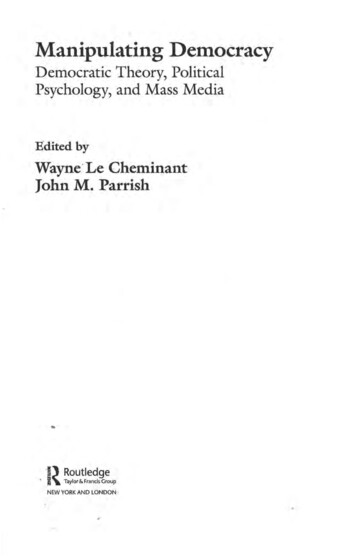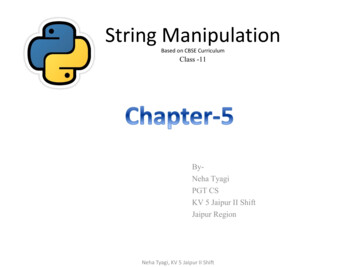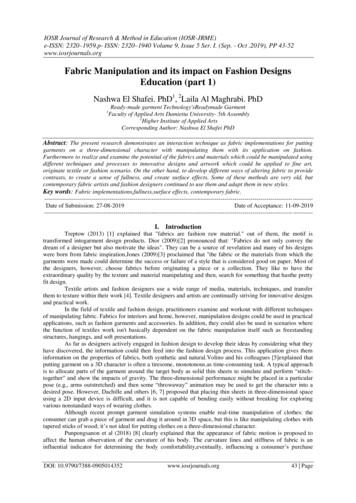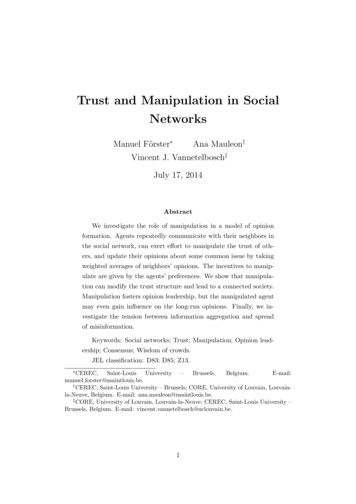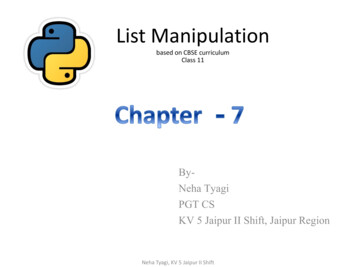
Transcription
List Manipulationbased on CBSE curriculumClass 11ByNeha TyagiPGT CSKV 5 Jaipur II Shift, Jaipur RegionNeha Tyagi, KV 5 Jaipur II Shift
Introduction In Python, a list is a kind of container that contains collectionof any kind of values. A List is a mutable data type which means any value from thelist can be changed. For changed values , Python does notcreate a new list. List is a sequence like a string and a tuple except that list ismutable whereas string and tuple are immutable. In this chapter we will see the manipulation on lists. We willsee creation of list and various operation on lists via built infunctions.Neha Tyagi, KV 5 Jaipur II Shift
List Creation List is a standard data type of Python. It is a sequence whichcan store values of any kind. List is represented by square brackets “ [ ] “For ex []Empty list [1, 2, 3]integers list [1, 2.5, 5.6, 9]numbers list (integer and float) [ ‘a’, ‘b’, ‘c’]characters list [‘a’, 1, ‘b’, 3.5, ‘zero’] mixed values list [‘one’, ’two’, ’three’] string list In Python, only list and dictionary are mutable data types, restof all the data types are immutable data types.Neha Tyagi, KV 5 Jaipur II Shift
Creation of List List can be created in following ways Empty list L [] list can also be created with the following statementL list( ) Long listseven [0, 2, 4, 6, 8, 10 ,12 ,14 ,16 ,18 ,20 ] Nested list L [ 3, 4, [ 5, 6 ], 7]Another methodNeha Tyagi, KV 5 Jaipur II ShiftThis is tuple
Creation of List-As we have seen in the exampleThat when we have suppliedvalues as numbers to a list even thenThey have automatically converted to string– If we want to pass values to a list in numeric form then we have to writefollowing function eval(input())L eval(input(“Enter list to be added “))eval ( ) function identifies type of the passed string and then return it.Another exampleString ValuesNeha Tyagi, KV 5 Jaipur II Shift
Accessing a ListFirst we will see the similarities between a List and a String.List is a sequence like a string.List also has index of each of its element.Like string, list also has 2 index, one for forward indexing (from0, 1, 2, 3, .to n-1) and one for backward indexing(from -n to 1). In a list, values can be accessed like string. Forward index 0List RBackward index -1412345678910 11 12 13ESPONSIBILITY-13-12-11-10-9-8-7-6-5-4-3-2-1Neha Tyagi, KV 5 Jaipur II Shift
Accessing a List len( ) function is used to get the length of a list.Important 1:membershipoperator (in, not in) worksin list similarly as they workin other sequence. L[ i ] will return the values exists at i index. L [ i : j ] will return a new list with the values from i index to j index excludingj index.Important 2: operatoradds a list at the end ofother list whereas *operator repeats a list.Neha Tyagi, KV 5 Jaipur II Shift
Difference between a List and a String Main difference between a List and a string is that string isimmutable whereas list is mutable. Individual values in string can’t be change whereas it ispossible with list.Value didn’tchange in string.Error shown.Value got changedin list specifyinglist is mutableNeha Tyagi, KV 5 Jaipur II Shift
Traversal of a list Traversal of a list means to access and process each andevery element of that list. Traversal of a list is very simple with for loop –for item in list :*Python supports UNICODE thereforeoutput in Hindi is also possibleNeha Tyagi, KV 5 Jaipur II Shift
Comparison of Lists Relational operators are used to compare two different lists. Python compares lists or tuples in lexicographical order,means comparing sequences should be of same type andtheir elements should also be of similar type.Someexamples In first example, python did notraise the error because both thelists are same. In second comparison, both thelists are not similar hence, pythonraised the error.Neha Tyagi, KV 5 Jaipur II Shift
List Operations ( , *) Main operations that can be performed on lists are joining list,replicating list and list slicing. To join Lists, operator , is used which joins a list at the end ofother list. With operator, both the operands should be of listtype otherwise error will be generated. To replicate a list, * operator , is used.Neha Tyagi, KV 5 Jaipur II Shift
List Slicing To slice a List, syntax isseq list [ start : stop ] Another syntax for List slicing is –seq list[start:stop:step]Neha Tyagi, KV 5 Jaipur II Shift
Use of slicing for list Modification Look carefully at following examples-New value is being assigned here.Here also, new value is being assigned.See the difference between both the results.144 is a value and not a sequence.Neha Tyagi, KV 5 Jaipur II Shift
List Manipulation Element Appending in Listlist.append(item) Updating List elementslist[index] new value Deletion of List elementsImportant: delcommand can beused to delete anelement of the listor a complete sliceor a complete list.del list[index]Important: if we write del list completelist will be deleted.Neha Tyagi, KV 5 Jaipur II Shift
List Manipulation Only one element will be deleted on pop() from list. pop ( ) function can not delete a slice. pop ( ) function also returns the value being deleted.list.pop( index )Last item6th item1st itemNeha Tyagi, KV 5 Jaipur II Shift
List Functions and Methods– Python provides some built-in functions for list manipulation– Syntax is like list-object . method-name FunctionDetailsList.index( item )Returns the index of passed items.List.append( item )Adds the passed item at the end of list.List.extend( list )Append the list (passed in the form of argument) at the end of listwith which function is called.List.insert( pos , item )Insert the passed element at the passed position.List.pop( index )Delete and return the element of passed index. Index passing isoptional, if not passed, element from last will be deleted.List.remove( value )It will delete the first occurrence of passed value but does notreturn the deleted value.Neha Tyagi, KV 5 Jaipur II Shift
List Functions and MethodsFunctionDetailsList.clear ( )It will delete all values of list and gives an empty list.List.count ( item )It will count and return number of occurrences of the passed element.List.reverse ( )It will reverse the list and it does not create a new list.List.sort ( )It will sort the list in ascending order. To sort the list in descendingorder, we need to write----- list.sort(reverse True).Neha Tyagi, KV 5 Jaipur II Shift
List Functions and Methods List.index ( ) function: List.append( ) function: List.extend( ) function: List.insert( ) function:Neha Tyagi, KV 5 Jaipur II Shift
List Functions and Methods List.pop ( ) function: List.remove( ) function: List.count( ) function:Neha Tyagi, KV 5 Jaipur II Shift
List Functions and Methods List.reverse( ) function: List.sort( ) function:Important To sort a list in reverse order, write in following manner–List.sort(reverse True) If a list contains a complex number, sort will not work.Neha Tyagi, KV 5 Jaipur II Shift
Thank youPlease follow us on our blog-www.pythontrends.wordpress.comNeha Tyagi, KV 5 Jaipur II Shift
List Manipulation based on CBSE curriculum Class 11 By- Neha Tyagi PGT CS KV 5 Jaipur II Shift, Jaipur Region Neha Tyagi, KV 5 Jaipur II Shift . Introduction Neha Tyagi, KV 5 Jaipur II Shift In Python, a list is a kind of


